 Overview
Overview
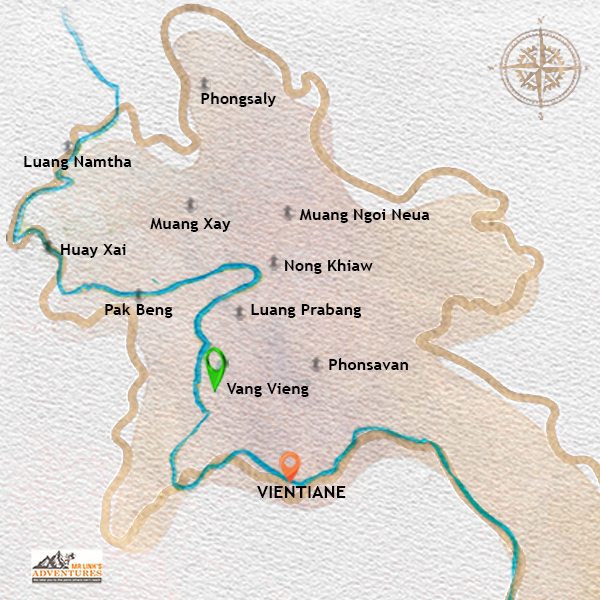 Vientiane
Vientiane, the capital of Laos, is a charming and peaceful city that offers a unique blend of French and Asian influences. Its unique atmosphere is easily discovered on foot or by bicycle thanks to its grid-like layout.
Further north, Vang Vieng, once infamous for its excessive festive atmosphere, has reinvented itself. Now, this small town, nestled in the heart of grandiose landscapes, offers a multitude of activities for travelers seeking adventure and nature.
The region around Vientiane and Vang Vieng is a true paradise for lovers of nature and adventure, with many outdoor activities and interesting cultural sites to discover.
 Top Attractions
Top Attractions
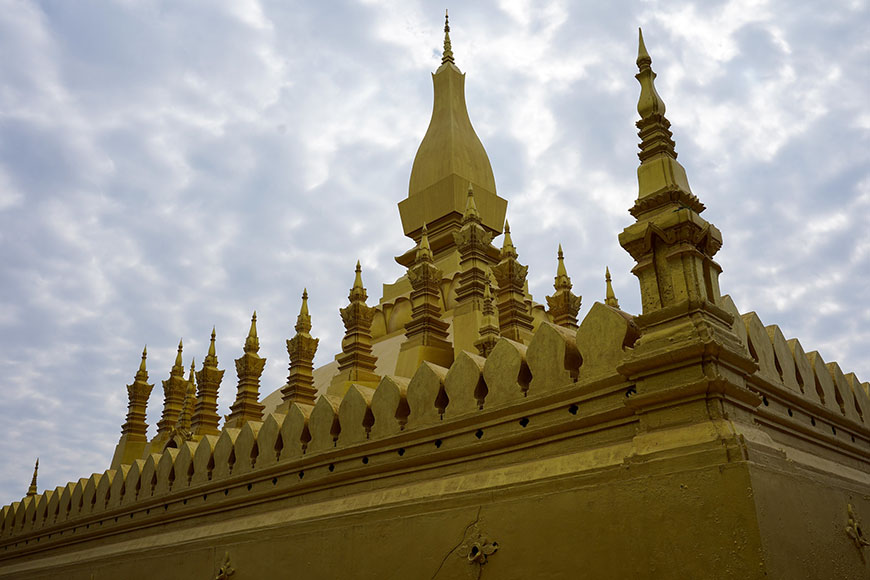 The emblematic stupa of That Luang - Mr Linh's Adventures
The emblematic stupa of That Luang - Mr Linh's AdventuresBuddha Park
Just about 25 kilometers from the bustling Vientiane lies the serene Buddha Park, an enchanting place where impressive Buddhist and Hindu sculptures stand amidst lush greenery. This park offers a fascinating immersion into a unique spiritual and artistic world.
That Luang
Back in the capital, the majestic That Luang is unmissable, an emblematic stupa that rises proudly as a national symbol of Laos, radiating an aura of peace and history. Venturing a little further, the Vang Vieng region reveals a network of spectacular caves, true invitations to exploration.
The Caves of Vang Vieng
Among them, Tham Nam Cave offers a watery adventure while Tham Chang Cave unveils striking rock formations and breathtaking panoramas.
The Nam Song River
Finally, the peaceful Nam Song River meanders through picturesque landscapes, offering an oasis of tranquility where you can enjoy kayaking, swimming, or simply relax on its banks, lulled by the gentle murmur of the water.
 See & Do
See & Do
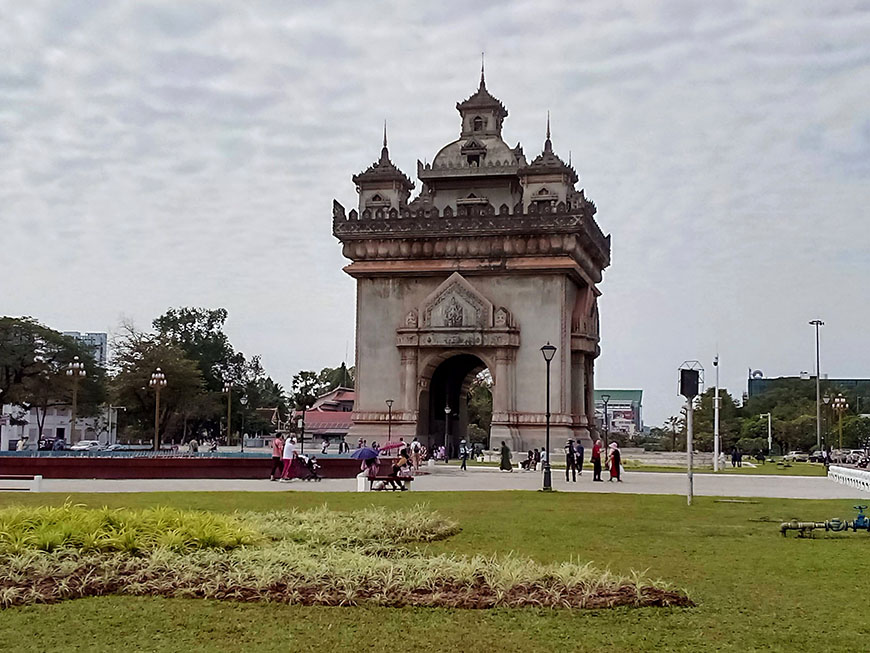 Patuxai, the Arc de Triomphe of Vientiane - Mr Linh's Adventures Team
Patuxai, the Arc de Triomphe of Vientiane - Mr Linh's Adventures Team
Vientiane, Vang Vieng, and their surroundings are full of activities for all tastes.
Vientiane is a relatively large city, but it is a true paradise for pedestrians. Most of the tourist sites are located in the city center, and the rest is easily accessible by bicycle or on foot.
The most remarkable monument in the city is undoubtedly the Patuxai, the Arc de Triomphe of Vientiane. Officially called the "Victory Monument," it commemorates those who lost their lives during the pre-revolutionary wars. Built in 1969, it may seem a bit anachronistic among the more traditional monuments, but it remains an impressive structure.
For coffee lovers, a visit to the Sinouk Coffee Pavilion is a must. Located at the headquarters of the famous brand, you can discover the secrets of coffee production, from bean to cup, and of course, taste the finished product.
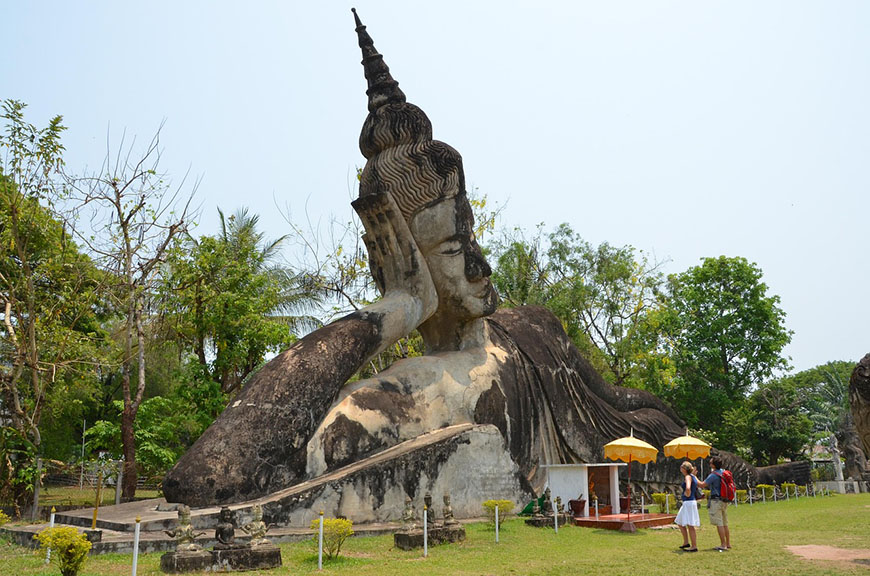 The bizarrely beautiful Buddha Park in Vientiane
The bizarrely beautiful Buddha Park in Vientiane
If you are ready to explore a little further, a bike or tuk-tuk ride will take you to Buddha Park, or Wat Xieng Khouane Luang. This unusual place, created by the shaman Luang Pu, brings together sculptures inspired by Buddhist and Hindu mythologies, offering a unique spiritual blend.
Want a break away from the city? The Phu Khau Khuay National Park, a vast expanse of more than 2,000 km², is the most accessible protected area in Laos. Hikes of a few hours to several days, winding rivers, sandstone mountains, threatened fauna and flora, spectacular waterfalls... the possibilities are endless.
From the village of Ban Na, set off for a day hike to the Tat Fa waterfall, or opt for a shorter walk to the old elephant observation post, where you can spend the night under a mosquito net. From the picturesque village of Ban Hat Khai, explore the cliffs of Pha Luang or the forests of Huay Khi Ling. Camping excursions are also possible to discover the waterfalls of Tat Xai, Pha Xai and Tat Leuk.
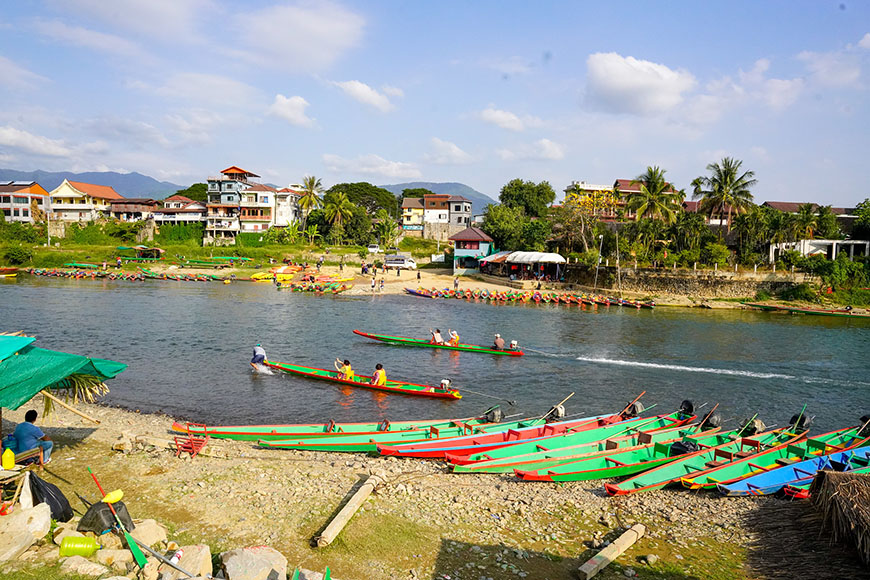 Vang Vieng, a pure paradise for kayaking - Mr Linh's Adventures
Vang Vieng, a pure paradise for kayaking - Mr Linh's Adventures
Vang Vieng, formerly known for its sometimes excessive festive atmosphere, has undergone a remarkable transformation. Now, this city is a true paradise for adventurers. If the city itself does not present a great architectural interest, it is enough to cross the river to find yourself in the heart of an exceptional natural landscape.
Activities abound: tubing, kayaking, climbing, zip-lining... Tubing, descending the Song River on a buoy, is an emblematic activity of Vang Vieng. Once popular with young people in search of thrills, it is now recommended to practice it in all sobriety, as the current can sometimes be fast.
If you prefer a more tranquil and personalized experience on the river, kayaking is an excellent alternative to tubing. This activity allows you to explore at your own pace the many caves that line the river. Many local operators also offer excursions combining kayaking and caving, or even climbing, for a complete adventure.
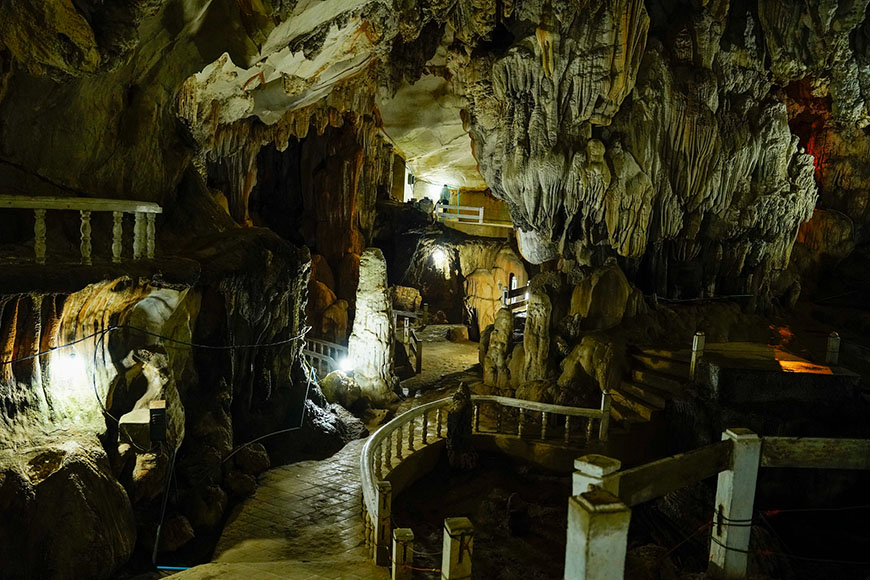 Tham Cham Cave - aka Tham Jang Cave - is a spectacular cave in Vang Vieng - Mr Linh's Adventures
Tham Cham Cave - aka Tham Jang Cave - is a spectacular cave in Vang Vieng - Mr Linh's Adventures
Vang Vieng is famous for its many caves, each offering a unique experience. The Tham Nam cave, 500 meters long, is particularly impressive with its entrance crossed by a river. Tham Jang, for its part, is famous for having served as a refuge during the Chinese invasions at the beginning of the 19th century. The largest are Tham Hoi, which extends over 3 km and houses an underground lake, and Tham Phu Kham, which also has a sacred underground lagoon where visitors can swim. Finally, Tham Loup is a wilder cave, with its giant stalactites that seem to crawl from the ceiling.
The limestone cliffs that surround Vang Vieng are known to be among the most beautiful climbing sites in Southeast Asia. Many routes have been laid out, ranging from the easiest, such as those of Tham Non, to the most difficult, such as the "Sleeping Wall" with its impressive overhangs. Note, however, that the climbing season generally runs from October to May, due to the excessive humidity the rest of the year.
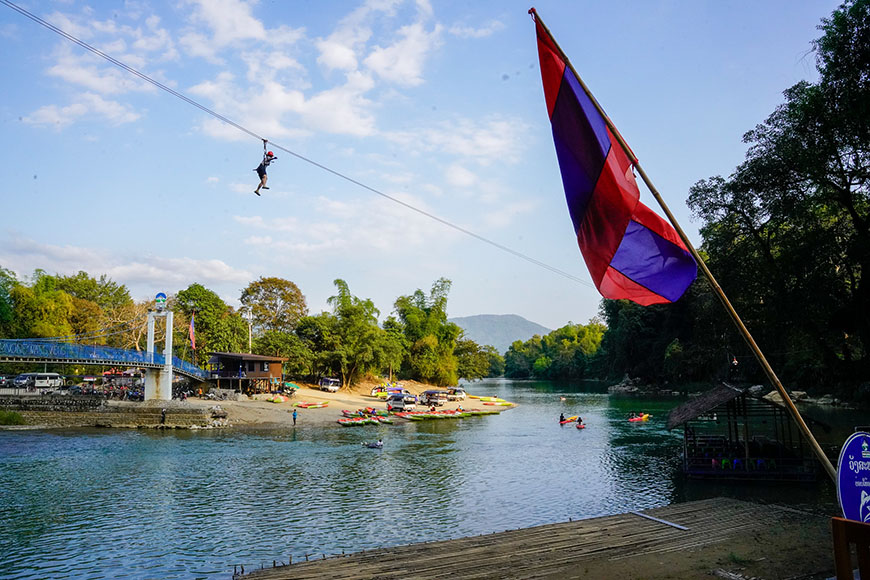 zip-lining is an unmissable activity in Vang Vieng - Mr Linh's Adventures
zip-lining is an unmissable activity in Vang Vieng - Mr Linh's Adventures
For thrill-seekers, zip-lining is an unmissable activity in Vang Vieng. But if you want to gain even more height, why not opt for a hot air balloon flight? This unique experience will offer you an unforgettable panoramic view of the grandiose landscapes that surround the city.
 Go Green
Go Green
Mr Linh's Adventures offers tailor-made tours to discover the Middle Mekong and its surroundings:
• Cruise on the Mekong and discovery of ethnic villages: A multi-day adventure that will take you to meet local communities, while offering you breathtaking landscapes.
• Trekking in the jungle and exploration of caves: An immersion in wild nature, discovering local fauna and flora.
• Combined Mekong and Luang Prabang: A trip that will allow you to discover the must-sees of the Middle Mekong and the city of Luang Prabang, a UNESCO World Heritage Site.
 Heritage
Heritage
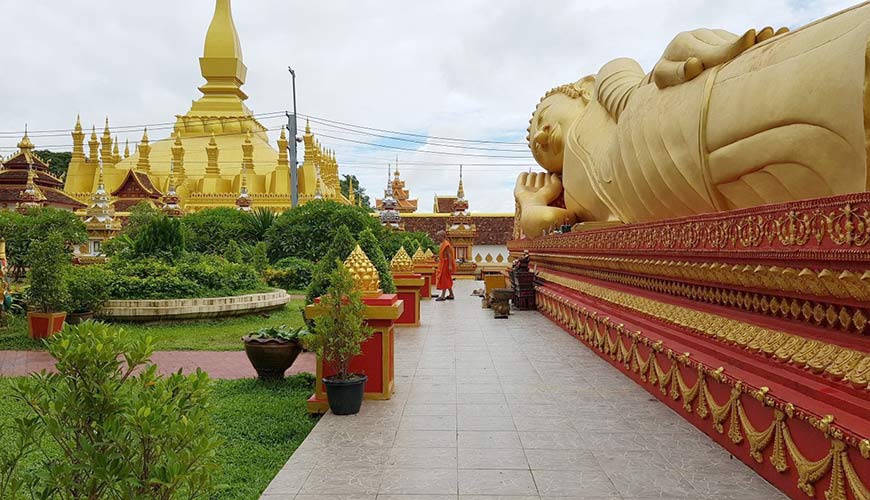 Pha That Luang is one of Laos' most impressive religious structures in Laos
Pha That Luang is one of Laos' most impressive religious structures in Laos
The region of Vientiane and Vang Vieng is rich in history and culture.
Vientiane, the former capital of the kingdom of Lan Xang, has many temples and historical sites.
The Wat Si Saket, the oldest in the city, and the Haw Pha Kaeo, which once housed the famous Emerald Buddha, are must-sees.
The Wat Si Muang, for its part, is the most visited temple. It houses the "pillar of the city," believed to house the guardian spirit of Vientiane, as well as a copy of the Emerald Buddha and an ancient bronze Buddha reputed to grant wishes. Do not miss the Wat Chathabuli, with its imposing bronze Buddha overlooking the Mekong, the Wat Mixai and its impressive gates guarded by statues, and the Wat Ong Tey Mahawihan, rebuilt after being destroyed during the Indochina wars.
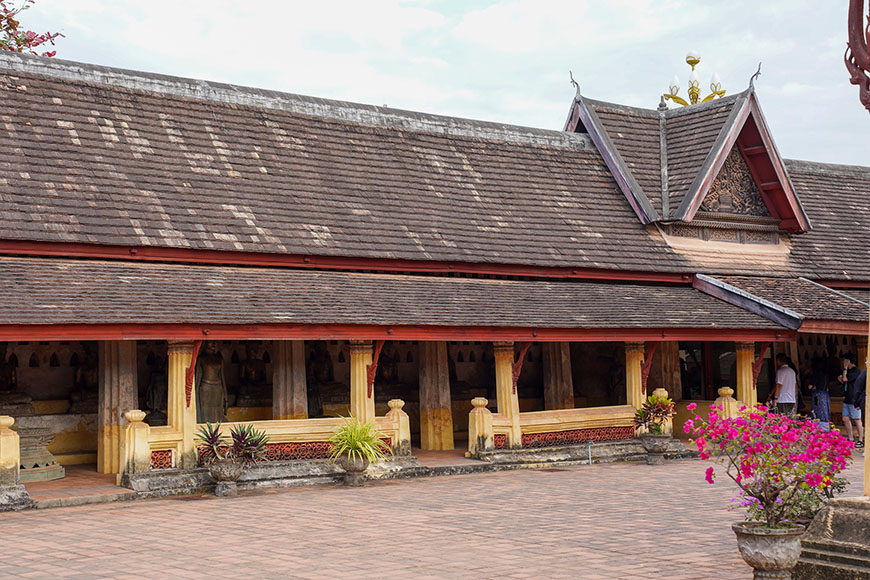 Wat Si Sa Ket is the oldest temple in Vientiane - Mr Linh's Adventures
Wat Si Sa Ket is the oldest temple in Vientiane - Mr Linh's Adventures
The Pha That Luang is undoubtedly the most important monument in Laos, a must-see for any visitor to Vientiane. This impressive stupa, a symbol of the nation, invites contemplation. Buddhist doctrine is engraved on three levels, offering visitors a glimpse into this philosophy. According to local legend, the stupa was built by Indian Buddhist missionaries who came to Laos to house a fragment of the Buddha's sternum.
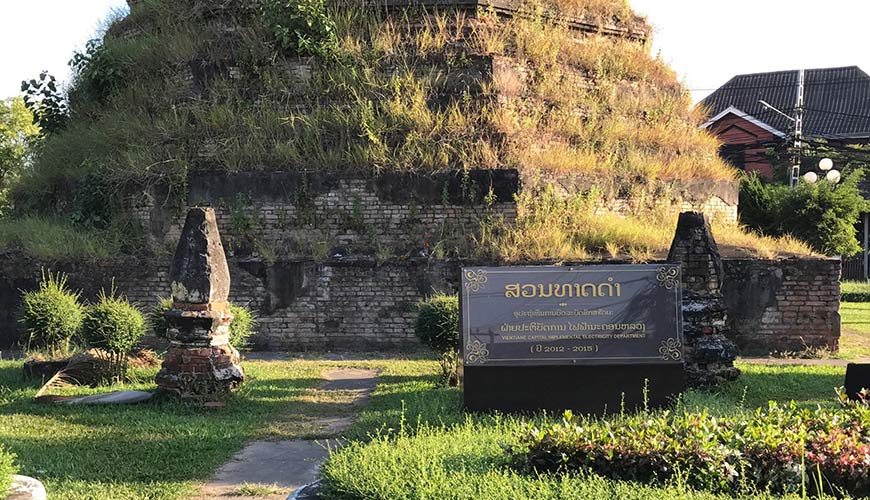 The That Dam Stupa is believed to house a dormant seven-headed serpent that once protected Vientiane
The That Dam Stupa is believed to house a dormant seven-headed serpent that once protected Vientiane
Kaysone Phomivane, an emblematic figure of modern Laos, is honored in Vientiane through his residence, the Kaysone Phomivane Memorial, and a museum retracing his life. His house, surprisingly well preserved, offers an intimate glimpse into his life, with personal objects and souvenirs from his time. The museum, although mainly in Lao, can be explored with a guide for a better understanding.
Not far from there, the That Dam, a formerly gilded stupa, bears witness to the difficult moments in the history of Vientiane. Stripped of its ornaments by the Siamese, it remains a symbol of mourning and resilience.
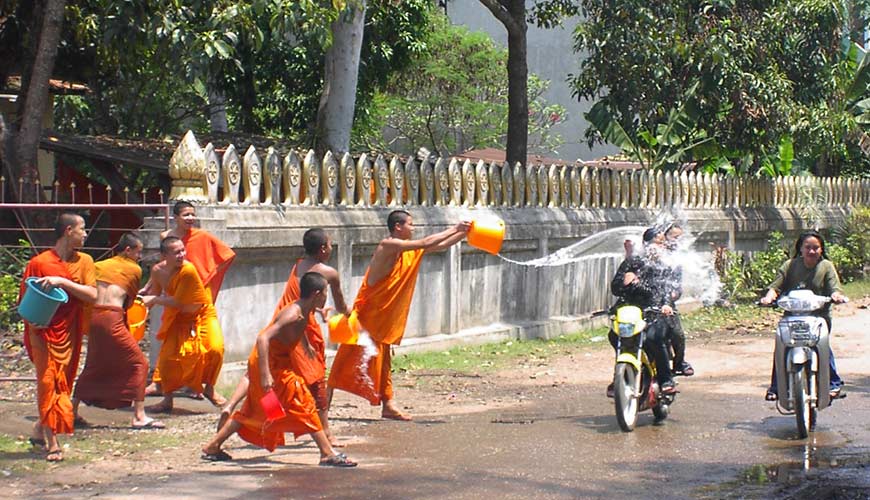 Celebrating Pi Mai
Celebrating Pi Mai
Pi Mai, the Lao New Year (sometimes called Songkran), is celebrated in mid-April and is probably the country’s most famous festival. This festival, which lasts three days, is a long water war where everyone, including tourists, is considered an easy prey. Get a water gun and join the party, but watch out for the kids who are waiting to throw a bucket of water on your head! Although the festival is very fun and not to be missed, do not forget to regularly rinse your eyes with bottled water, as water guns are often filled with water coming directly from the Mekong.
 Food & Drinks
Food & Drinks
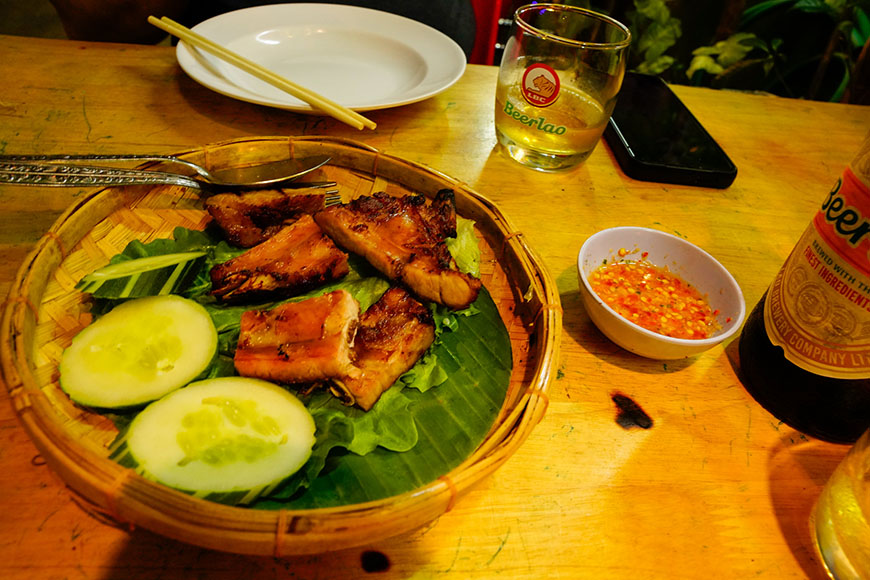 Vientiane is a premium destination for food lovers - Mr Linh's Adventures
Vientiane is a premium destination for food lovers - Mr Linh's Adventures
Vientiane is not content to delight the eyes, it also delights the taste buds.
Vientiane has a lot to offer the palates of travellers. It is easy to find a wide variety of international dishes and fusion cuisine, as well as modern reimaginings of basic Laotian dishes like the Larb. The Mekong fish is also a local favourite, whether it’s grilled or used in Koy Pqa, a freshwater fish salad.
Vientiane is a city where noodles are queen. With hundreds of variations, there is something for everyone. The most popular dish is undoubtedly Fer, a local version of Vietnamese Pho.
 Directions
Directions
Location & how to get there
Vientiane is located in the center of Laos and is easily accessible by plane from many cities in Asia, notably Hanoi. The price of the plane ticket varies depending on the airline and the season.
Best season to visit
The best season to visit Vientiane and Vang Vieng is from November to March, during the dry season. The temperatures are pleasant and the sky is generally sunny.